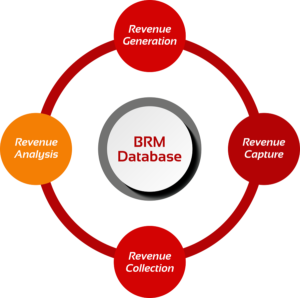Billing and Revenue Management (BRM) is a vital component for businesses, particularly in customer-centric B2C industries like telecommunications. BRM systems effectively manage the entire revenue flow within an organization. At Aarav Solutions, we have a wealth of experience in implementing and testing BRM components, including Oracle BRM. In this article, we’ll explore the BRM Revenue Management Lifecycle and shed light on the different modules involved. Additionally, we’ll delve into the intricacies of testing within the BRM lifecycle, with a specific focus on Oracle BRM testing.
BRM Revenue Management Lifecycle:

1. Revenue Generation:
This module encompasses the services offered to customers, including customer service and product plans, as well as the pricing associated with those services. The primary objective is to connect customers with the right offerings at the appropriate prices while addressing any payment discrepancies that may arise.
2. Revenue Capture:
Revenue capture involves the process of recording relevant data when an event occurs, such as making a voice call or accessing the internet. For example, when you make a call, your account is authorized by validating your phone number. Call Detail Records (CDRs) capture information such as call duration, start and end times, and other details. The pipeline manager then checks the plan and rate for the call, and the data is stored in the BRM database by the RE (Rated Event) loader, which also updates the account with the new bill.
3. Revenue Collection:
In this module, all payment-related processes are handled. At the end of each billing cycle, invoices are generated and updated in the customer’s account. Various payment methods, including credit cards, debit cards, and checks, are supported. Additionally, automatic payment cycles can be set up, where the designated payment account is debited accordingly, with the transaction recorded in the BRM database.
4. Revenue Analysis:
The revenue analysis module involves developing detailed reports on customer account activities, such as call records and internet usage. These reports serve as valuable references for future decision-making or when modifying existing plans.
Oracle BRM Testing:
Within the BRM lifecycle, testing plays a crucial role in ensuring the system’s effectiveness. Specifically, Oracle BRM testing focuses on validating the BRM database and its associated components. Let’s explore the key aspects of Oracle BRM testing:
-
BRM GUI Testing:
In BRM GUI testing, our focus is on the revenue generation aspect, as it involves the UI interface accessed by customers and representatives. We conduct thorough testing of the UI’s functionalities, ensuring a seamless user experience. Our testing process includes verifying the accuracy of account information, testing service activation and deactivation, and validating pricing and billing functionalities.
-
API Testing:
API testing is a crucial component of Oracle BRM testing. It plays a vital role in ensuring the accuracy and reliability of backend operations and updates to customer accounts. By utilizing service calls, we can complete various functions and seamlessly update the BRM database. Our team at Aarav Solutions specializes in API testing and employs comprehensive methodologies to validate the API functionalities, data integrity, and system integration.
During API testing, we verify the correctness of API endpoints, perform data validation and verification, and assess the system’s response to different API calls. This includes testing functionalities such as creating and updating customer accounts, modifying service plans, processing payments, and retrieving account information. Our meticulous API testing approach guarantees that the BRM system effectively communicates with external applications and services, ensuring smooth data flow and efficient operations.
-
BRM Database Testing:
The BRM database serves as a fundamental module within the BRM Server Architecture, storing critical information such as customer account details, personal information, payment details, service plans, billing information, pricing and rating details, and business-related information. Additionally, it contains call data, including start and end times, minutes utilized, and rating plans.
At Aarav Solutions, we have developed a hybrid testing framework tailored specifically for BRM systems. This framework allows us to connect to the Browser UI, capture essential parameters, and validate them against the data stored in the database. For example, when creating a new account, we dynamically retrieve unused device numbers, such as Serial Number/IMEI, from the BRM database. These numbers are then incorporated into the account creation request or input. Customer accounts can be created via the BRM GUI or through API calls on SOAP Client.
Conclusion:
Oracle BRM testing is an integral part of ensuring the accuracy, reliability, and seamless functioning of the BRM system. At Aarav Solutions, we bring extensive expertise in testing BRM components, including Oracle BRM. By employing a hybrid framework, incorporating BRM GUI testing, API testing, and thorough BRM database testing, we aim to deliver high-quality testing solutions. Our focus on comprehensive validation, data integrity, and system integration ensures that the BRM system performs optimally, enabling businesses to effectively manage their billing and revenue management processes.






